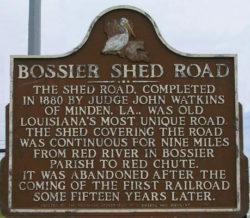Shed Road
The South's first all-weather turnpike was Louisiana's most unique road, built in the 1870s in Bossier Parish.

Courtesy of Wikimedia Commons
Bossier Shed Road. Unknown
Shed Road was the South’s first all-weather turnpike, built in the 1870s in Bossier Parish. The private, nine-mile toll road was one of the state’s most unique, constructed so that nineteenth-century wagons—particularly those carrying commodities to market—could travel without fear of mud, swamps, or inclement weather. In a sense, it was an extension of the old northern concept of a covered bridge, built to keep ice off bridges in wintertime; but in Louisiana, ice was not a problem so much as swampy quagmires. Today a paved road by the same name follows the same route as the old covered structure.
Origins
Shed Road was without counterpart in the nation. It was largely the idea of Judge John Dyer Watkins, a Minden attorney who may have been inspired by a similar, but much shorter, temporary covered road built between Shreveport’s Fort Turnbull (now Fort Humbug) and Battery 3 during the Civil War. No road occupies that site today, but the location is roughly parallel to, and thought to have been a bit north of, present-day Stoner Avenue.
A partner in the realization of Shed Road appears to have been Mary D. C. Cane, a New Hampshire native whose recollections of New England’s covered bridges helped formulate the ultimate design of the roadway. Cane, a prominent Bossier Parish planter (and widow of two of the original eight founders of Shreveport), owned a considerable portion of the land over which Shed Road ran. It began at her riverfront plantation, Elysian Grove, and ended near the property of her granddaughter, Anna McCormick Stockwell.
The thoroughfare was a graded, though unpaved, highway, wide enough for two teams of mules or oxen to pass one another. It extended from the Red River, about where the Texas Street Bridge crosses today, eastward to the foothills of Red Chute at Stockwell Road. This was the original Shed Road—nine miles long and dry all year round. It was an engineering feat, although no engineer is known to have been involved in its creation. Watkins said on many occasions that mules making the trip regularly were known to bray excitedly upon entering the covered road, seemingly in recognition of the easy traveling that lay ahead.
Construction and Use
Construction began in late 1872, and the project provided employment for many who lost their jobs in the depression of 1873. Workers were employed at seventy-five cents per day to dig drainage ditches along the road’s edge for its entire length. Soil from the ditches was piled onto the roadbed, elevating it as high as three feet. Heavy cypress posts cut from nearby woods were then set up at intervals of twenty feet to support the roof structure. A beam fourteen inches tall was set upright atop the center of the roofing joists. Roofing boards were then bent across the structure and nailed down at the eaves like boxcar roofs. It took until 1880 for the entire length of Shed Road, which included several bridges, to be completed.
As costs for labor and building materials steadily rose, Watkins called on the merchants of Shreveport to assist in funding the project. His—correct—theory was that the merchants of Shreveport had the most to gain by the road’s success. The merchants, however, did not display much interest, and assistance came from only a few Shreveport businessmen.
Shed Road was a private venture, built not out of altruism but entirely for profit, and, indeed, it turned out to be very profitable. Tolls were charged for all vehicles, horses, pedestrians, and others passing along, and they were collected at the various intersection points at which traffic entered the roadway. The amount of the toll varied according to the nature of the user. Despite a construction cost of between $5,000 and $8,500 per mile, Shed Road brought in a profit of more than $20,000 in its short lifetime as a private highway.
Decline
The 1884 completion of the Vicksburg, Shreveport, and Pacific Railroad through Bossier Parish (roughly parallel to today’s Interstate 20) sharply diminished the need for a covered roadway to bring cotton and other goods from Bossier and Webster Parishes to Shreveport’s markets and to New Orleans. By late 1887 Shed Road was no longer profitable and Watkins relinquished its ownership to Bossier Parish.
Upon receiving custody of Shed Road, the Bossier Parish Police Jury set out to determine the costs of necessary upkeep and repairs. Upon finding that certain portions had grown unsafe and that replacement or repairs would be costly, the parish opted to demolish parts of the structure. Within a few years, the entire structure was abandoned, and today only the name Shed Road remains.
